通信网基本概念与主体结构(第二版)答案Ch1
通信网——基本概念与主体结构ch2要点
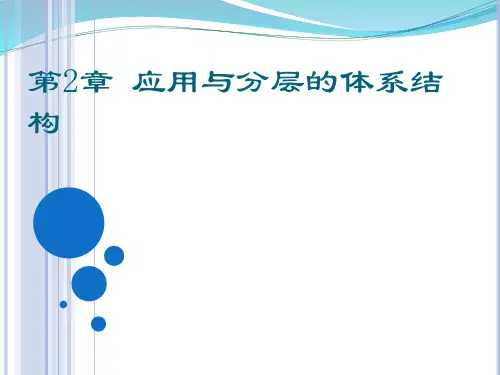
面向连接的服务(connection-oriented- service)包含
3个步骤:
在两个n层SAP问建立连接。该建立过程包括协商连 接参数和初始化“状态信息”,如序号、流量控制变 量与缓存位置等。
利用n层协议实际传送n—SDU。 断开连接,释放用于该连接的各种资源。
HTTP驻留程序在TCP连接上发送文件,然后断开连接. 其间客户机接收文件并加以显示。为了取出图像,浏览 器必须启动另一TCP连接,用于GET交互作用。
HTTP与Web页浏览
在HTTP情况下,需双向连接,以 正确的次序无误地传送字节流。
TCP协议能够提供这种通信业务 , 每 个 HTTP 进 程 都 将 报 文 插 入 一缓存器内,由TCP以信息块(段 )形式将其传送到另一TCP进程, 每 段 包 含 端 口 号 , 加 到 HTTP 报 文 信 息 中 。 HTTP 利 用 底 层 TCP 提 供 服 务 , 这 样 , HTTP 客 户 机 与服务器间报文的传送实际上是
OSI参考模型
网络层(network layer)提供经通信网的分组(packet)
数据传送,其关键问题是为从源端设备到目的端设备的 分组选择路由,所谓路由选择,就是为通过网络的分组 选择路径的方法。网络中的各节点必须协同工作,以有 效地完成路由的选择。这一层还涉及由于分组信息流的 剧增而引起的拥塞问题。
图2.1对等通信
OSI参考模型 在OSI术语中,第n层的进程称作第n层实体(layer n entity)。第n层实体间通过交换协议数据单元 (protocol data unit,PDU)进行通信。每个PDU包 括一个头部,而头部中含有协议控制信息。通常用户 信息为服务数据单元(service data unit SDU)格式。n 层实体的行为由一组规则或约定进行管理,通常将这 些规则与约定称作第n层协议(layer n protoc0l)。
计算机网络(第二版)课后习题答案第一章
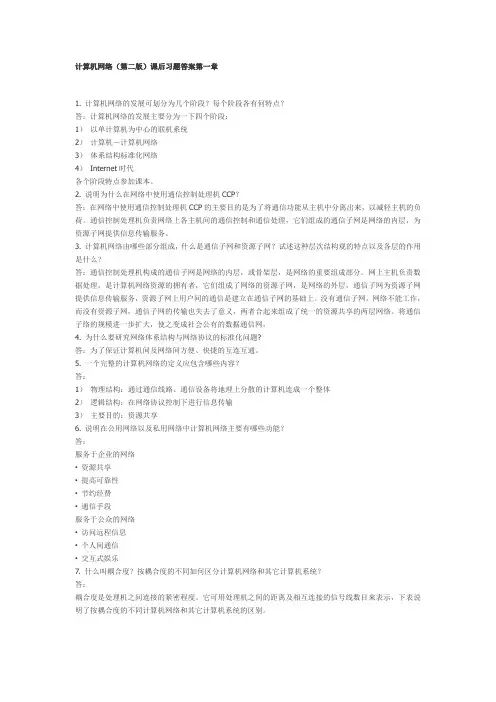
计算机网络(第二版)课后习题答案第一章1. 计算机网络的发展可划分为几个阶段?每个阶段各有何特点?答:计算机网络的发展主要分为一下四个阶段:1)以单计算机为中心的联机系统2)计算机-计算机网络3)体系结构标准化网络4)Internet时代各个阶段特点参加课本。
2. 说明为什么在网络中使用通信控制处理机CCP?答:在网络中使用通信控制处理机CCP的主要目的是为了将通信功能从主机中分离出来,以减轻主机的负荷。
通信控制处理机负责网络上各主机间的通信控制和通信处理,它们组成的通信子网是网络的内层,为资源子网提供信息传输服务。
3. 计算机网络由哪些部分组成,什么是通信子网和资源子网?试述这种层次结构观的特点以及各层的作用是什么?答:通信控制处理机构成的通信子网是网络的内层,或骨架层,是网络的重要组成部分。
网上主机负责数据处理,是计算机网络资源的拥有者,它们组成了网络的资源子网,是网络的外层,通信子网为资源子网提供信息传输服务,资源子网上用户间的通信是建立在通信子网的基础上。
没有通信子网,网络不能工作,而没有资源子网,通信子网的传输也失去了意义,两者合起来组成了统一的资源共享的两层网络。
将通信子络的规模进一步扩大,使之变成社会公有的数据通信网,4. 为什么要研究网络体系结构与网络协议的标准化问题?答:为了保证计算机间及网络间方便、快捷的互连互通。
5. 一个完整的计算机网络的定义应包含哪些内容?答:1)物理结构:通过通信线路、通信设备将地理上分散的计算机连成一个整体2)逻辑结构:在网络协议控制下进行信息传输3)主要目的:资源共享6. 说明在公用网络以及私用网络中计算机网络主要有哪些功能?答:服务于企业的网络•资源共享•提高可靠性•节约经费•通信手段服务于公众的网络•访问远程信息•个人间通信•交互式娱乐7. 什么叫耦合度?按耦合度的不同如何区分计算机网络和其它计算机系统?答:耦合度是处理机之间连接的紧密程度。
它可用处理机之间的距离及相互连接的信号线数目来表示,下表说明了按耦合度的不同计算机网络和其它计算机系统的区别。
计算机网络基础(第二版)习题参考答案
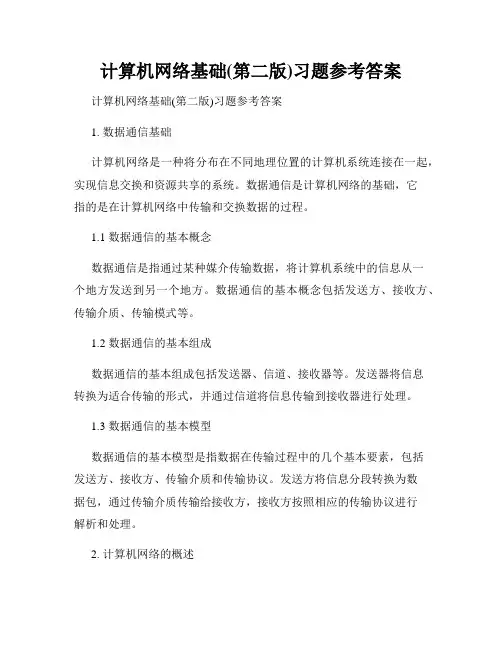
计算机网络基础(第二版)习题参考答案计算机网络基础(第二版)习题参考答案1. 数据通信基础计算机网络是一种将分布在不同地理位置的计算机系统连接在一起,实现信息交换和资源共享的系统。
数据通信是计算机网络的基础,它指的是在计算机网络中传输和交换数据的过程。
1.1 数据通信的基本概念数据通信是指通过某种媒介传输数据,将计算机系统中的信息从一个地方发送到另一个地方。
数据通信的基本概念包括发送方、接收方、传输介质、传输模式等。
1.2 数据通信的基本组成数据通信的基本组成包括发送器、信道、接收器等。
发送器将信息转换为适合传输的形式,并通过信道将信息传输到接收器进行处理。
1.3 数据通信的基本模型数据通信的基本模型是指数据在传输过程中的几个基本要素,包括发送方、接收方、传输介质和传输协议。
发送方将信息分段转换为数据包,通过传输介质传输给接收方,接收方按照相应的传输协议进行解析和处理。
2. 计算机网络的概述计算机网络是指将多台计算机系统通过通信线路或其他传输介质连接起来,实现信息交换和资源共享的系统。
2.1 计算机网络的分类根据规模和范围的不同,计算机网络可以分为局域网(LAN)、城域网(MAN)和广域网(WAN)等不同类型。
2.2 计算机网络的体系结构计算机网络的体系结构包括物理层、数据链路层、网络层、传输层和应用层等不同层次。
每一层负责不同的功能,通过协议进行通信和交互。
3. TCP/IP协议世界TCP/IP是互联网的核心协议,由传输控制协议(TCP)和互联网协议(IP)组成。
3.1 TCP/IP协议的基本原理TCP/IP协议是一种面向连接的协议,通过将数据分割成数据段并进行封装,使用IP地址将数据段传输到目的地,再通过TCP协议实现数据的可靠传输。
3.2 TCP/IP协议的层次结构TCP/IP协议的层次结构包括网络接口层、网络层、传输层和应用层等不同层次。
每一层负责不同的功能,通过协议进行通信和交互。
3.3 TCP/IP协议的应用TCP/IP协议广泛应用于互联网和局域网等不同的网络环境中。
线务工程(第2版)第一章第一部分 通信工程基础知识第二部分 通信工程基础建设第三部分 通信工程施工
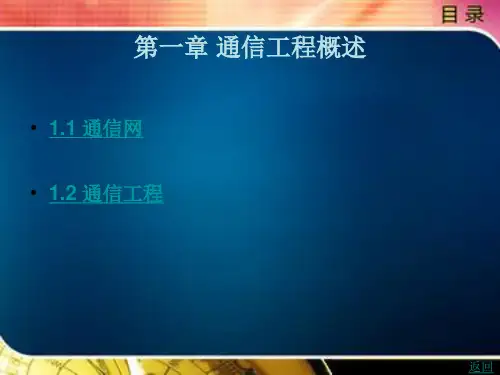
• 1.1 通信网 • 1.2 通信工程
返回
1.1 通 信 网
• 1.1.1 通信网的基本概念
• 通信网(telecommunicationnetwork)是构成多个用户相互通信的多 个电信系统互联的通信体系,是人类实现远距离通信的重要基础设施, 利用电缆、无线、光纤或者其他电磁系统,传送、发射和接收标识、 文字、图像、声音或其他信号。电信网由终端设备、传输链路和交换 设备三要素构成,运行时还应辅之以信令系统、通信协议以及相应的 运行支撑系统。
• 1.1.3 通信网的基本结构
• 任何通信网都具有信息传送、信息处理、信令机制、网络管理功能。 一个完整的通信网,尤其是面对普通用户运营的大型通信网络,一般可 以分为业务网、传输网和支撑网三个部分。
上一页 下一页 返回
1.1 通 信 网
• 1.1.4 通信网的拓扑结构
• 通信网的拓扑结构有网状网、星型网、环型网、总线型网、复合型网 等。
网、传真通信网、图像通信网、有线电视网等。 • 按服务区域范围可分为:本地电信网、农村电信网、长途电信网、移
动通信网、国际电信网等。 • 按传输媒介种类可分为:架空明线网、电缆通信网、光缆通信网、卫
星通信网、用户光纤网、低轨道卫星移动通信网等。 • 按交换方式可分为:电路交换网、报文交换网、分组交换网、宽带交
信工程项目,地市局工程项目。 • (4)四类工程 • 县局工程项目,其他小型项目。 • 2. 按项目建设范围划分 • (1)一般施工项目 • 一般施工项目是指按照单独的设计文件,单独进行施工的通信项目建
设工程。一般施工项目通常是雇主与施工队伍相互配合、协作,施工 团队根据雇主的设计文件进行施工。
上一页 下一页 返回
(完整版)通信网络课后题答案
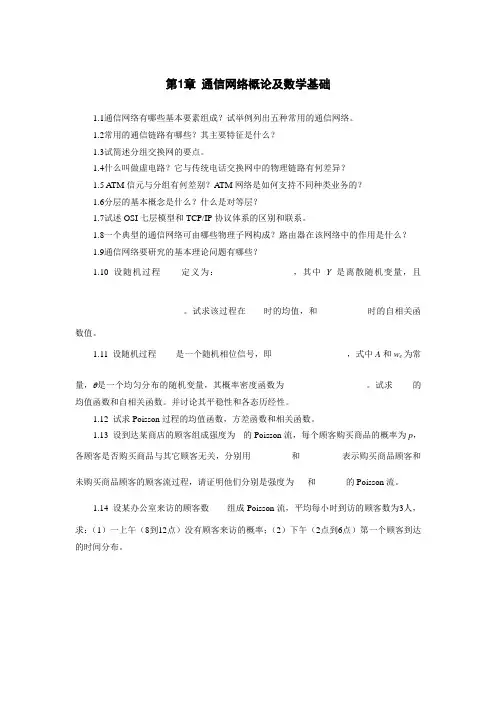
第1章通信网络概论及数学基础1.1通信网络有哪些基本要素组成?试举例列出五种常用的通信网络。
1.2常用的通信链路有哪些?其主要特征是什么?1.3试简述分组交换网的要点。
1.4什么叫做虚电路?它与传统电话交换网中的物理链路有何差异?1.5 A TM信元与分组有何差别?ATM网络是如何支持不同种类业务的?1.6分层的基本概念是什么?什么是对等层?1.7试述OSI七层模型和TCP/IP协议体系的区别和联系。
1.8一个典型的通信网络可由哪些物理子网构成?路由器在该网络中的作用是什么?1.9通信网络要研究的基本理论问题有哪些?1.10 设随机过程定义为:,其中Y是离散随机变量,且。
试求该过程在时的均值,和时的自相关函数值。
1.11 设随机过程是一个随机相位信号,即,式中A和w c为常量, 是一个均匀分布的随机变量,其概率密度函数为。
试求的均值函数和自相关函数。
并讨论其平稳性和各态历经性。
1.12 试求Poisson过程的均值函数,方差函数和相关函数。
1.13 设到达某商店的顾客组成强度为的Poisson流,每个顾客购买商品的概率为p,各顾客是否购买商品与其它顾客无关,分别用和表示购买商品顾客和未购买商品顾客的顾客流过程,请证明他们分别是强度为和的Poisson流。
1.14 设某办公室来访的顾客数组成Poisson流,平均每小时到访的顾客数为3人,求:(1)一上午(8到12点)没有顾客来访的概率;(2)下午(2点到6点)第一个顾客到达的时间分布。
图1-25习题1-16图1.15 设有三个黑球和三个白球,把这六个球任意分给甲乙两人,并把甲拥有的白球数定义为该过程的状态,则有四种状态0,1,2,3。
现每次从甲乙双方各取一球,然后相互交换。
经过n次交换后过程的状态记为,试问该过程是否是马氏链?如是,试计算其一步转移概率矩阵,并画出其状态转移图。
1.16分别利用Prim-Dijkstra算法和Kruskal算法求解图1-25中的最小重量生成树。
通信网-基本概念与主体结构第二版教学设计
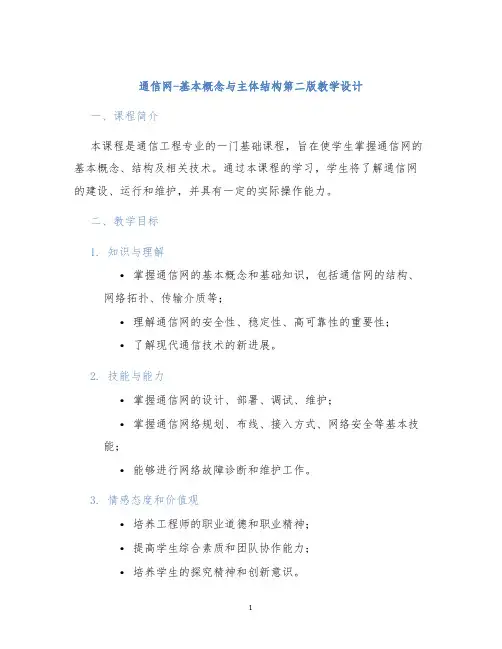
通信网-基本概念与主体结构第二版教学设计一、课程简介本课程是通信工程专业的一门基础课程,旨在使学生掌握通信网的基本概念、结构及相关技术。
通过本课程的学习,学生将了解通信网的建设、运行和维护,并具有一定的实际操作能力。
二、教学目标1. 知识与理解•掌握通信网的基本概念和基础知识,包括通信网的结构、网络拓扑、传输介质等;•理解通信网的安全性、稳定性、高可靠性的重要性;•了解现代通信技术的新进展。
2. 技能与能力•掌握通信网的设计、部署、调试、维护;•掌握通信网络规划、布线、接入方式、网络安全等基本技能;•能够进行网络故障诊断和维护工作。
3. 情感态度和价值观•培养工程师的职业道德和职业精神;•提高学生综合素质和团队协作能力;•培养学生的探究精神和创新意识。
1. 通信网基础概念•通信核心技术•通信网络基本概念和拓扑•通信介质特点和相互作用•通信网络的分类和特征2. 通信网的基本组成•通信网的结构•通信协议栈•通信子系统和接口•通信设备的分类和功能3. 通信网络与互联网的关系和发展趋势•通信网络的发展历程•互联网的产生和发展•通信网络与互联网的优化和融合•未来通信网络的发展方向和趋势四、教学方法本课程采用“理论教学+实践操作”相互结合的教学方法。
教师将通过多种途径传递通信网络的基本概念和原理,并引导学生进行全方位、实地的实验操作。
1. 学生的要求•具备一定的数学功底和物理知识;•具备基本计算机应用能力;•具备较强的组织协调和沟通能力。
2. 教师的要求•具备扎实的专业基础和丰富的实践经验;•熟练掌握教学内容,拥有良好的教学能力;•能够激发学生的学习兴趣,培养学生的实践操作能力。
3. 设备要求•课堂需要用到计算机、服务器、交换机、路由器等设备;•给学生提供实验室环境和相应的软硬件设施。
六、教学评价授课结束后,将通过以下方式对学生的学习情况进行评价:•课堂小测验:通过简单的测试,了解学生对课程知识的掌握程度;•实验考核:对学生在实验室中的表现进行考核;•期末考试:考验学生对整个课程的掌握情况;•个人项目:通过个人项目的完成情况评价学生的综合能力和实践操作能力。
通信网—基本概念与主体结构AlbertoLeon-GarciaIndraWidjaja)课程设计 (
通信网—基本概念与主体结构课程设计一、课程概述本课程旨在介绍通信网的基本概念和主体结构,深入探讨通信网络中所涉及的各种技术和协议,并且提供相应的实践措施。
通信网作为现代社会的核心基础设施,对于信息交流和经济发展具有重要意义。
因此,了解通信网的基本概念和主体结构是非常必要的。
二、课程目标1.了解通信网络的基本概念,包括计算机网络、数据通信、网络拓扑结构等。
2.掌握通信网络中所使用的各种协议和技术,包括TCP/IP协议、HTTP协议、路由选择算法等。
3.熟悉通信网络的主体结构,包括物理结构、逻辑结构和分层结构等。
4.能够应用所学知识,完成相应的通信网络实践,包括局域网的构建、应用程序的开发等。
三、课程大纲第一章:引言在本章中,将介绍通信网络的基本概念,包括计算机网络、数据通信、网络拓扑结构等。
第二章:协议和技术在本章中,将深入探讨通信网络中所使用的各种协议和技术,包括TCP/IP协议、HTTP协议、路由选择算法等。
第三章:通信网络主体结构在本章中,将详细介绍通信网络的主体结构,包括物理结构、逻辑结构和分层结构等。
第四章:通信网络的实践在本章中,学员将进行相应的通信网络实践,包括局域网的构建、应用程序的开发等。
四、考核要点1.学员需要在考试中准确地描述通信网络的基本概念和主体结构。
2.学员需要具备掌握各种协议和技术的能力,并且在实践中加以应用。
3.学员需要进行相应的通信网络实践,包括局域网的构建、应用程序的开发等。
五、参考资料1.周志华,《计算机网络》。
2.Andrew S. Tanenbaum,《计算机网络》。
3.W. Richard Stevens,《TCP/IP详解(卷一)》。
六、总结本课程介绍了通信网络的基本概念和主体结构,并且深入探讨了通信网络中所涉及的各种技术和协议。
学员在学完本课程后,应该具备了一定的通信网络应用程序开发能力,并且可以在实践中加以应用。
通信网基本概念与主体结构(第二版)答案Ch3
8. How many HDTV channels can be transmitted simultaneously over the optical fiber transmission systems in Table 3.3?
Solution:
Suppose that an optical fiber carries 1600 x 109 bps, and an HDTV channel is about 38 Mbps, then the fiber can carry about 1600000/38 = 40,000 HDTV channels.
4. Explain the difference between facsimile, GIF, and JPEG coding. Give an example of an image that is appropriate to each of these three methods.
Solution:
9. Comment on the properties of the sequence of frame images and the associated bit rates in the following examples.
计算机网络与通信(第2版)课后习题参考答案
解答:
以传递邮件为例。首先,E-mail数据通过本地计算机(信息源)发送给Modem(变换器),完成数字信号到模拟信号的转换,然后通过电话线(信道)传送到目的地的Modem
(反变换器),完成模拟信号到数字信号的转换,然后送给目的地计算机(受信者),从而完成整个数据的传输。
#include <stdio.h>
#include <graphics.h>
#include <stdlib.h>
#include <conio.h>
/*函数:初始化图形显示模式。*/
void InitPaint(void)
{
int gdriver = DETECT, gmode, errorcode;
(3)报文交换采用"存储-转发"方式进行传送,无需事先建立线路,事后更无需拆除。它的优点是:线路利用率高、故障的影响小、可以实现多目的报文;缺点是:延迟时间长且不定、对中间节点的要求高、通信不可靠、失序等,不适合计算机网络。
(4)分组交换中数据以短分组的形式传输,分组长度一般为1000字节。如果发送端有更长的报文需要发送,那么这个报文被分割成一个分组序列,每个分组由控制信息和用户数据两部分组成。分组交换适用于计算机网络,在实际应用中有两种类型:虚电路方式和数据报方式。分组交换的优点是:高效、灵活、迅速、可靠、经济,但存在如下的缺点:有一定的延迟时间、额外的开销会影响传输效率、实现技术复杂等。
目前光纤的最大传输速率可达10Gbps的数量级。
2.3 无线电通信频率范围是多少?无线电广播频谱和微波频谱各是多少?
解答:
无线电通信频率范围为3KHz~300GHz,无线电广播频谱为30 MHz~1 GHz,微波频谱为2~40 GHz。
通信网基本概念与主体结构(第二版)答案Ch6
- 1、下载文档前请自行甄别文档内容的完整性,平台不提供额外的编辑、内容补充、找答案等附加服务。
- 2、"仅部分预览"的文档,不可在线预览部分如存在完整性等问题,可反馈申请退款(可完整预览的文档不适用该条件!)。
- 3、如文档侵犯您的权益,请联系客服反馈,我们会尽快为您处理(人工客服工作时间:9:00-18:30)。
Solutions to Chapter 11a. Describe the step-by-step procedure that is involved from the time you deposit a letter in a mailbox to the time the letter is delivered to its destination. What role do names, addresses and mail codes (such as ZIP codes or postal codes) play? How might the letter be routed to its destination? To what extent can the process be automated?Solution:The steps involved in mailing a letter are:1. The letter is deposited in mailbox.2. The letter is picked up by postal employee and placed in sack.3. The letter is taken to a sorting station, where it is sorted according to destination, asdetermined by the mail code and grouped with other letters with the same destination mailcode. (If there is no mail code, then it is determined by the largest geographical unit, forexample, country (if specified), otherwise state (if specified), otherwise city (if specified).)4. The letter is shipped to the post office that handles the mail for the specific mail code (orcountry or city).5. The letter is then sorted by street address.6. The letter is picked up at the post office by the postal worker responsible for delivering to thespecified address.7. The letter is delivered according to the number and street.The name is not really used, unless the street address is missing or incorrect. The name is at the destination to determine who the letter belongs to. (Unless of course the letter is being sent to a small town, where most inhabitants are known to the postal worker.)The mail delivery process can be automated by using optical recognition on the mail code. The letter can then be sorted and routed to the destination postal station, and even to the destination neighborhood, depending on the amount of geographical detail built into the mail code.1b. Repeat part (a) for an e-mail message. At this point, you may have to conjecture different approaches about what goes on inside the computer network.Solution:The steps involved in e-mailing a message are:1. The message is sent electronically by clicking 'Send'. (In Chapter 2 we see that the SimpleMail Transfer Protocol (SMTP) is used to do this.)2. The mail provider of the sender sends a request to a name server for the network address ofthe mail provider of the recipient. The mail provider is determined by the information followingthe @ symbol.3. If the mail provider finds the network address of the recipient's mail provider, then it sends themessage to that address.4. Upon receipt of the message the mail provider either informs the recipient automatically thatthere is mail or waits until mail is requested by the recipient, depending on how the mailservice is set up. The recipient is determined by the information before the @ symbol.1c. Are the procedures in parts (a) and (b) connection-oriented or connectionless?Solution:The transfer service of letters in a postal system is connectionless. Users do not set upconnections prior to the transfer of each letter. (Note however that the postal system may have regularly scheduled shipments of bundles of mail from city to city, because the volume of mailbetween cities is predictable. These regular shipments can be viewed as pre-arranged"connections.")E-mail transfer is also a connectionless service in that the user does not set up end-to-endconnections to send a message. We will see in Chapter 2, however, that e-mail protocols useconnection-oriented procedures to exchange messages.NOTE: For parts (a) and (b) other step-by-step procedures are possible.2a. Describe what step-by-step procedure might be involved inside the network in making a telephone connection.Solution:1. The telephone number specifies an "address" where the receiver is located. In the NorthAmerican telephone numbering system the first three digits are the area code which specifiesthe main geographical region of the receiver; the next three digits specify a particulartelephone office in the North American network. The final four digits identify the particularlocation of the receiver.2. When a telephone number is dialed equipment at the other end of the telephone line uses thesequence of dialed numbers to determine a route across the telephone network from the call-originating phone to the destination phone. A circuit is established between the originatingand destination phone along the identified route.3. A ringing tone is then applied at the destination to indicate that there is an incoming call. If thedestination party (a person, an answering machine, or some other device) is ready to answer,the call is completed through the lifting of the phone set or some equivalent action. Thesetting up of telephone calls is discussed in Chapter 4.2b. Now consider a personal communication service that provides a user with a personal telephone number. When the number is dialed, the network establishes a connection to wherever the user is located at the given time. What functions must the network now perform in order to implement this service?Solution:1. The key difference here is that the personal telephone number is not tied to a specificlocation. Instead the personal number is associated with one or more pieces of equipment,for example, a cell phone, that can request service from various points in the network. Thisnecessitates the translation of the personal telephone number to a number that correspondsto a specific location in the network at a given time.2. When the telephone number is dialed, a message requesting a connection setup is sent tothe "home" location of the personal number.3. The home location must somehow be able to redirect the connection setup process to thecurrent location of the user. For example, the user may register one or more forwarding"addresses" to which calls are to be redirected. The signaling system is used to locate theuser. In cellular telephony, for example, requests for connections to a given mobiletelephone are broadcast over specific signaling channels.4. Once the location of the destination is identified a connection is established.3. Explain how the telephone network might modify the way calls are handled to provide the following services:Solutions follow questions:a.Call Display: the number and/or name of the calling party is listed on a screen before the call is answered.Along with the request for connection setup, the system sends identifying information regarding the originator's phone.b.Call Waiting: a special sound is heard when the called party is on the line and another user is trying toreach the called party.When a second caller tries to access a busy line, the system applies an audible sound, for example, a "beep" or a tone, to the voice signal that is being sent to the called party. The tone alerts the called party that there is an incoming call and provides the choice of answering the second call without disconnecting the first call.c.Call Answer: if the called party is busy or after the phone rings a prescribed number of times, the networkgives the caller the option of leaving a voice message.If the call is not answered after so many rings, the system establishes a connection to anothernumber (that is, forwards the call) that is associated with the answering system. The call is then automatically answered by an answering system.d.Three-Way-Calling: allows a user to talk with two other people at the same time.After the establishment of a call between two parties, the caller can then indicate to the telephone system that he or she wants to call a third party. Without disconnecting the first pair, the system sets up a connection to the second called party, and once established, transmits both conversations to all parties simultaneously. Special equipment is required to combine and distribute the voice signals of the three parties.4a. Suppose that the letter in problem 1 is sent by fax. Is this mode of communications connectionless or connection-oriented? Real-time or non-real time?Solution:In order to send the letter by fax, a telephone connection must first be established. Therefore the mode of communications is connection-oriented. The transfer of information across the network occurs in real-time.4b. Repeat part (a) if a voice mail message is left at a given telephone.Solution:Again, the process of leaving a voice mail message is connection-oriented, since there must be anend-to-end connection between the caller and the receiver with the answering service. The leaving of voice mail is also done in real-time. However, the mode of communication between the person that leaves the voice mail and the person that listens to the voice mail is connectionless and non-real-time. The people involved do not need to establish a simultaneous connection with each other in order to communicate; also, they record and listen to the messages at different times.5. Suppose that network addresses are scarce, so addresses are assigned so that they are not globally unique; in particular suppose that the same block of addresses may be assigned to different organizations. How can the organizations make use of these addresses? Can users from two such organizations communicate with each other?Solution:To make the example concrete suppose that two organizations are assigned the same set oftelephone numbers. Clearly, users within each organization can communicate with each other as long as they have a unique address within the organization. However, communications outside anorganization poses a problem since any given address is no longer unique across multipleorganizations.A possible approach to enabling communications between users in different organizations is to use atwo-step procedure as follows. Each organization has a special gateway to communicate outside the organization. Internal users contact the gateway to establish calls to other organizations. Gateways have procedures to establish connections with each other. This enables gateways to establishconnections between their internal users and users in other networks.6a. Describe the similarities and differences in the services provided by (1) a music program delivered over broadcast radio and (2) music delivered by a dedicated CD player.Solution:Both broadcast radio and a dedicated CD player provide users with similar types of information and with almost the same performance. However the broadcast radio offers its service in a real-time fashion with no interaction with users. A CD player, on the other hand, stores its information on a CD and delivers it on demand.6b. Describe how these services might be provided and enhanced by providing them through a communications network.Solution:Broadcast radio is typically transmitted in real time using radio waves "over the air." Broadcast audio programs can also be transmitted over any communication network. Furthermore, when stored in servers that are attached to a network, "broadcast" audio programs can be retrieved for listening at a later time. Indeed a server can also store CD audio material and retrieve it on demand. If the network and server are sufficiently responsive, it may also be possible to provide the interactivity of a personal CD player through a network-based service.7a. Use the World Wide Web to visit the sites of several major newspapers. How are these newspapers changing the manner in which they deliver news services?Solution:Traditionally, newspapers deliver news in printed "hard-copy" form in various editions during the day.The information is primarily in text form, supplemented by still pictures and graphics. The information in a newspaper is organized in several sections: main page, business, local, sports, classifieds, etc.Some of the revenue of newspapers is from subscriptions, but most of the newspaper revenue is usually from advertising.In the traditional model, getting the news from a particular newspaper required getting the physical printed form. The WWW and the Internet allow newspapers to deliver information in electronic form and at any time that a user requests it. Newspaper information on the Web still consists mostly of text, images, and graphics that can be retrieved and displayed readily by a Web browser. In most cases, subscription is not required and advertising is displayed along with news information. In order to be competitive, newspapers can no longer work in terms of editions, especially for late-breaking news. Instead, news items are updated continuously day and night. The use of a Web browser allowsa user to quickly find the news items of interest. In addition, newspapers can provide more in-depthcoverage in their web page on topics of special interest than is possible in print medium.7b. Now visit the websites of several major television networks. How are they changing the manner in which they deliver news over the Internet? What differences, if any, are there to the approach taken by television networks and newspapers?Solution:Traditionally, television networks deliver news using audio, video, and graphics, with very little text.News is traditionally delivered in programs that are broadcast at various times of the day. Again, the information is organized in several sections: international, business, sports, entertainment, etc. The revenue in television news is almost entirely from advertising. The WWW and the Internet allow users to retrieve news information in electronic form and at any time. However, the transmission of audio and video over the Internet poses a challenge, so this information must be transmitted in compressed form and in relatively low quality. Consequently, more of the information is provided in text form. The dependence on audio and video also required the development of applications for the decompression and display of such information. Again, in order to be competitive, news networks update their Web pages continuously day and night as news develops. The higher cost involved in providing video service has led to the introduction of subscription fees.8. Discuss the advantages and disadvantages of transmitting fax messages over the Internet instead of the telephone network.Solution:The comparison of fax transmission over the Internet and over the telephone network reflect the differences between e-mail and telephone calls. The transmission of a fax message as an attachment to e-mail means that the transfer of the message is not in real time and that delivery is not necessarily confirmed. The transmission of a fax message over the telephone network, on the other hand, is real time and is confirmed with fairly high certainty. On the other hand, the cost of transmission of a fax message over the Internet is very inexpensive and is not distance-sensitive. The transmission of fax messages over telephone networks may involve long distance charges.9a. Suppose that an interactive video game is accessed over a communication network. What requirements are imposed on the network if the network is connection-oriented? connectionless?Solution:We suppose that the game involves the interaction between a player and a server across a network.To support an interactive video game over a communications network, the network, whetherconnection-oriented or connectionless, must provide real-time delivery of the player's commands to the server, and of the server's responses to the player. With a connection-oriented network,connections between the player and the servers transfer the sequence of commands and responsesthroughout the game with very little delay. In a connectionless network, user commands may be delivered to the other end with variable delay, out-of-sequence, or not at all. The user’s network software is responsible for ensuring the ordered and correct delivery of game commands. In-time delivery of commands cannot be assured.9b. Repeat part (a) if the game involves several players located at different sites.Solution:The requirements on the network depend on how the game is implemented. In the centralizedapproach the players interact through a central server that processes the commands from all of the players, maintains a view of the state of the overall system, and issues appropriate responses to all the players. Alternatively, the game could be implemented in a decentralized fashion, where each player receives commands from some or all of the players, maintains a local view of the system state, and transmits responses to some or all of the players.In the centralized approach, the network requirements are essentially the same as those in part (a). In the decentralized approach, the real-time response requirement may apply only to a subset of players when they happen to be interacting with each other. If players are located at different sites, thenetwork could provide multicast capability so messages can be exchanged among the server and all the players.9c. Repeat part (b) if one or more of the players is in motion, for example, kids in the back of the van during a summer trip.Solution:If one or more players is in motion, then the network must also be able to locate each mobile player and then deliver and receive information to and from such player. Additional delay and loss issues come into play when a mobile user is “handed-off” from one radio coverage area to another.10. Discuss the similarities between the following national transportation networks and a communications network. Is the transportation system more similar to a telephone network or to a packet network?Solution:Transportation networks are designed to transfer people and goods; communications networks are designed to transfer information. Like communication networks, all transportation systems involve links, in the form of roads, rails, or air corridors, and switching points, in the form of stations, airports, and highway interchanges. Addressing and geographical names are used in transportation networks to identify destinations, and routing of various forms is required to direct goods to their destinations.Transportation resources, in the forms of cars or airplanes, are shared or "multiplexed" amongvarious goods that traverse common parts of the network.a.Railroad network.Railroad network: Goods or people arrive at train stations and are loaded for transport to specific places. Tickets are purchased for a given destination, usually guaranteeing that there will be a place in a car from the starting station all the way to the destination station. This is similar to establishing a connection across a telephone network. Alternatively, a passenger may choose to purchase a ticket at each station along the way. This corresponds more closely to a connectionless packet network model.b.Airline network.Airline network: In this case passengers purchase tickets that guarantee a seat all the way to the destination, even if transfers are made at intermediate airports. This is similar to the establishment of connections across a telephone network.c.Highway system.Highway systems: Trucks or cars enter the highway without making reservations ahead of time and without informing any central authority of their destination or route. This mode of operationcorresponds closely to the operation of a connectionless packet network.bination of (a), (b), and (c).Combination of transportation systems: The combination of air, rail, and highway transportationsystems can and are used jointly for the transfer of people and goods. Each transportation system is different in how it is organized and how transfers are accomplished. Nevertheless, it is possible to use these systems in combination to provide a higher degree of connectivity between sources anddestinations of people and goods. We will see that the Internet plays a role similar to the combined transportation systems in that the Internet enables the transfer of information across multipledissimilar networks that may differ in how they are organized and how they operate.11. In the 1950s, standard containers were developed for the transportation of goods. These standard containers could fit on a train car, on a truck, or in specially designed container ships. The standard size of the containers makes it possible to load and unload them much more quickly than using non-standard containers of different sizes. Draw an analogy to packet switching communications networks. In your answer identify what might constitute a container and speculate on the advantages that may come from standard-size information containers.Solution:In a packet-switching communications network, the component that is analogous to the container is a constant-size packet (preferably of short length) that can be used for the transport of information.Transmission systems and networks of various types can be designed to transfer information of the given standardized size, much like trucks, trains, and ships can be designed to carry standardcontainers. Packing and unpacking of fixed-size units is simpler than packing and unpacking ofvariable-length units. Consequently, it is simpler to schedule the transfer of packets across switches that use constant-size packets than across switches that make use of variable-length packets.12. The requirements of world commerce led to the building of the Suez and Panama canals. What analogous situations might arise in communication networks?Solution:The Suez and Panama canals were built to provide a shorter path between geographical areas with major trade relationships. The analogous situation arises in communication networks when the path between two areas in the network are too "long" either in terms of excessive delay or inadequate capacity to transfer the required volumes of traffic. The addition of network resources to provide shorter paths for lower delay or wider paths for higher capacity corresponds to the building of a canal.13. Two musicians located in different cities wish to have a jam session over a communications network. Find the maximum possible distance between the musicians if they are to interact in real-time, in the sense of experiencing the same delay in hearing each other as if they were 10 meters apart. The speed of sound is approximately 330 meters/second. Assume that the network transmits the sound at the speed of light in cable, 2.3 x 108 meters/second.Solution:The first step is to find the delay for the sound when the musicians are 10 meters apart: t10 = 10/330 = 30.30 millisecondsThe maximum distance is the time required for a real-time 'experience' times the cable speed:d = (2.3 x 108) x (30.30 x 10-3) = 6,969,000 meters = 6969 kilometers14. The propagation delay is the time that is required for the energy of a signal to propagate from one point to another.a. Find the propagation delay for a signal traversing the following networks at the speed of light in cable (2.3 x 108 meters/second):• a circuit board 10 cm• a room 10 m• a building 100 m• a metropolitan area 100 km• a continent 5000 km•up and down to a geostationary satellite 2 x 36000 kmSolution:To find the propagation delay, divide distance by the speed of light in cable. Thus we have:• a circuit board t prop = 4.347 x 10-10 seconds• a room t prop = 4.3478 x 10-8 seconds• a building t prop = 4.3478 x 10-7 seconds• a metropolitan area t prop = 4.3478 x 10-4 seconds• a continent t prop = 0.02174 seconds•up and down to a geostationary satellite t prop = 0.31304 seconds14b. How many bits are in transit during the propagation delay in the above cases, if bits are entering the above networks at the following transmission speeds: 10,000 bits/second; 1 megabit/second; 100 megabits/second; 10 gigabits/second.Solution:The number of bits in transit is obtained by multiplying the transmission rate R by the propagation delay:Distance (m)10 Kbps 1 Mbps100 Mbps10 Gbps0.1 4.347 x 10−6 4.347 x 10−40.04347 4.347810 4.3478 x 10−40.043478 4.3478434.780100 4.3478 x 10−30.4347843.4784347.800100 000 4.3478434.7843478 4.3478x1065 000 000217.4217402174000 2.174x10872 000 0003130.431304031304000 3.1304x10915. In problem 14, how long does it take to send an L-byte file and to receive a 1-byte acknowledgment back? Let L=1, 103, 106, and 109 bytes.Solution:The total time required to send a file and receive an acknowledgment of its receipt is given by:t total = L message/R + L ack/R +2* t prop = L message/R + L ack/R + 2*d/cwhere L message is the message length in bits, L ack is the acknowledgment length in bits, R is thetransmission bit rate, d is the distance traversed, and c is the speed of light.The above equation shows that there are two main factors that determine total delay:1. Message and ACK transmission time, which depends on the message length and thetransmission bit rate;2. Propagation delay, which depends solely on distance.When the propagation delay is small, message and ACK transmission times determine the total delay. On the other hand, when the bit rate becomes very large, the propagation delay provides a delay component that cannot be reduced no matter how fast the transmission rate becomes.The tables below show the two main components of the total delay in microseconds. The message transmission time is shown in red and the propagation delay is shown in blue. The entries in the total delay tables are colored according to which delay component is dominant.Message + ACK delay @10 kbps Message +ACK delay@1 Mbpsmessage+ACK delay@100 Mbpsmessage+ACK delay@10 Gbps1600160.160.0016Distance (meters) 2 * prop. delay(microseconds)Total delay@10 kbpstotal delay@1 Mbpstotal delay@100 Mbpstotal delay@10 Gbps0.1 0.00087 1600.0008716.00086960.160870.0024710 0.086957 1600.08695716.08695650.2469570.088557100 0.869565 1600.86956516.8695652 1.0295650.871165 100000 869.5652 2469.565217885.565217869.7252869.5668 5000000 43478.26 45078.2608743494.260943478.4243478.26 72000000 626087 627686.9565626102.957626087.1626087 Table 1: Message length = 1 byteMessage + ACK delay @10 kbps message +ACK delay@1 MbpsMessage+ACK delay@100 Mbpsmessage+ACK delay@10 Gbps800800800880.080.8008Distance (meters) 2 * prop. delay(microseconds)Total delay@10 kbpstotal delay@1 MbpsTotal delay@100 Mbpstotal delay@10 Gbps0.1 0.00087 800800.00098008.0008780.080870.8016710 0.086957 800800.0878008.0869680.166960.887757100 0.869565 800800.86968008.8695780.94957 1.670365 100000 869.5652 801669.56528877.56522949.6452870.366 5000000 43478.26 844278.260951486.260943558.3443479.06 72000000 626087 1426886.957634094.957626167626087.8 Table 2: Message length = 1000 bytesMessage + ACK delay @10 kbps message +ACK delay@1 Mbpsmessage+ACK delay@100 Mbpsmessage+ACK delay@10 Gbps8.00E+088.00E+0680000.08800.0008distance (meters) 2 * prop. delay(microseconds)Total delay@10 kbpstotal delay@1 Mbpstotal delay@100 Mbpstotal delay@10 Gbps0.1 0.00087 8.00E+088.00E+0680000.08800.001710 0.086957 8.00E+088.00E+0680000.17800.0878100 0.869565 8.00E+088.00E+0680000.95800.8704 100000 869.5652 8.00E+088.00E+0680869.651669.566 5000000 43478.26 8.00E+088.04E+06123478.344278.26 72000000 626087 8.01E+088.63E+06706087626887 Table 3: Message length = 106 bytes。
